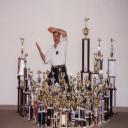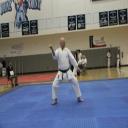Yahoo Answers is shutting down on May 4th, 2021 (Eastern Time) and beginning April 20th, 2021 (Eastern Time) the Yahoo Answers website will be in read-only mode. There will be no changes to other Yahoo properties or services, or your Yahoo account. You can find more information about the Yahoo Answers shutdown and how to download your data on this help page.
Trending News
Question for Karatekas, where do you focus your eyes when performing Kata?
I have noticed that I tend to look at the point where my hands or feet are going especially the limbs that are moving at that moment, I know that some of the arm and leg movements are not necessarily strikes and some are blocks, locks and throws, so I was wondering where you focus your eyes when performing these types of techniques in the kata. I was thinking when I perform an age uke or shuto uke for example, I find that I end up looking at my arm that's performing the block instead, when I suppose I should be looking at my imaginary opponent's vulnerable target opened up by the block movement. So now, I have another thing added to my "to do" list when training in kata.
Btw, for those who train in Kung Fu or TKD or other styles, please feel free to share your answer and experience as well.
Lots of helpful answers here. The reason I asked is because I consider my habit of looking at my arms and legs while doing kata a bad habit and have only recently realized I was unconsciously doing it, probably to correct my form, I know if I don't nip it in the bud now, that's how I'm probably gonna end up doing all kata. Which brings me to the question where to look and at which point in the kata to look elsewhere, obviously when you're punching or kicking you look directly at the opponent or your target, but when you're performing a throw or a lock or any of the other applications of kata where would you look? It's nitpicking I know, but I'm kind of a curious cat, so bear with me on this.
15 Answers
- SiFu frankLv 61 decade agoFavorite Answer
I was taught to look where I'm striking and kicking or grabbing than to immediately look to the opponents other limb if appropriate or to where ever it makes sense.
Forms are a kind of shadow fight so you need to practice to put your gaze where it makes sense. If you get in the habit of looking at your posture to correct it you will end up doing it in a fight and that will get you in trouble. I have had my Master run through my forms with me as the shadow fighter and strike from where I wasn't looking to prove the point. A real eye opener!
As for throws well we are always taught that when in a self defense situation always assume your opponent has cohorts and they are waiting to attack. So when not engaged in striking and parrying you need to look around. I always look around after every finishing blow or throw. This is a great question. and responses are great. There is a lot for us to think about as instructors.
Source(s): My Master and His master before him. - Darth ScandalousLv 71 decade ago
Oh, I got punched or kicked for looking anywhere other than straight forward, and I am very glad to have been forced to. This did something for me that those bad habits would have prevented. It gave me a special gift that developed from this.
What I noticed as I became an advanced student was that my vision expanded to the point where it seemed that I am able to see through or with my whole body while doing kata.
It's like I can see all around me but it's more a perception than actually seeing.
And I know for a fact that it's the Breathing combined with the KIME - focus, that does this.
I realized it when learning new kata. You learn the kata step by step with the breath and apply the breath in sync when you have the mechanics down properly.
As I am repeating it to make it second nature, the breathing and kime is what enhances my perception and I see after I'm done how I was able to notice everything around me during the execution.
This is why it is important to adhere to the Principles and Theories that make for completeness in training. The martial arts cannot make you invincble but proper training makes you an extraordinary and enhance individual.
- mafundhelperLv 51 decade ago
In our group (kaiha) we have specific set areas to look at in kata. Typically it is where the opponent is. (Although on an escape from a rear choke/grab, we will usually look straight ahead...) But in my own training I will occasionally experiment with this. However, I would very rarely ever look at the technique. That seems a foolish thing to do... but maybe I am missing some deeper meaning?
I have read arguments for and against looking at the eyes. I am one for looking around the mouth. From there I can see the eyes, I can see the shoulders and such. I can also see if there is any laboured breathing or extra exertion/frustration. And it is harder to be fooled by the eyes. But, very few people are really good at using their eyes. So, I usually teach lower level students to start with looking at the eyes.
- 1 decade ago
That's a good question and I was taught that if you have to look at the block for any length of time to consider its form or when executing it and to make sure you are doing or finishing it correctly then your form is weak for that technique. Also you should only have to look at the technique that you are blocking if we are talking application for just a split second and only for blocking or parrying it and then re-divert your attention from that technique back to your opponent for countering or handling the next attack. So in blocking I glance for timing it but never actually look to check the form-I know the form is correct from practicing countless hours and days, those techniques you use in blocking and parrying.
In attacking I focus on the area that I am attacking if we are talking kata, always striving for accuracy, speed, power,and correct technique and the best blend of it. A student should never just execute an offensive technique without aiming it in kata or practice. This helps develop accuracy later on in application. However in actual fighting or actual application you don't look at that area or target per say lest your opponent seeing this, knows what your intentions might be and what area you are going to attack. Instead, look at the whole person and keep your face expressionless and no change in breathing, posture, weight distribution, and balance or as little change as possible. Doing this gives your opponent nothing to key on or use.
Here again practice is important in this and take shadow boxing or shadow fighting in the mirror for instance. If when doing your best and strongest techniques, combinations, and attacks in the mirror and you can see or notice a change and give it away or the fact that you are about to do something then your opponent also sees this usually. You probably do the same thing in actual fighting or will in actual application and this can have negative results.
Its a good question and I encourage students to look at things as they do them and we sometimes even practice doing them slowly to better see what we are doing right or wrong and what changes are needed to make it better or improve on it. Then as they develop their speed and ability to do it faster and stronger while still doing it correctly I encourage them to look at it a little less and maybe only occasionally check it. Eventually they can do it with out having to look at all and you should know by feel and not just by sight if you are doing something correctly or well and that's an important thing in learning and mastering a technique I think irregardless if it is a block, strike, kick, or punch.
In closing sometimes a student will become reliant on using and needing mirrors to do something correctly. When this happens the instructor needs to ween them from this and instead have the student learn by feel and knowing and reinforce that so that a student does not always have to look or is only looking for the right reasons and at the proper time. "Looking" during actual application is not the same as looking during practice and for improvement.
- How do you think about the answers? You can sign in to vote the answer.
- IDCLv 51 decade ago
When performing Kata, I tend to focus on the area where my next technique or movement is going to occur. Techniques in kata tend to be either 1- a serious of techniques (a combination), 2- a 'finishing technique', or 3- a set up for a 'finishing technique'. As such the target of the technique is expected to be either moving, in which case the karate-ka should focus on where they are moving to, or neutralized allowing the karate-ka to focus on the 'next threat'.
Of course it varies dependign on the kata, and which technique you are perfroming, but I generally look toward the next technique.
Source(s): Nidan Shotokan Karate-do - Rob BLv 71 decade ago
I don't focus on a particular spot, but in the area of the imagined attacker. That may go back to being taught when sparring to look to the center of mass of my opponent but don't focus on any one thing. Focusing on too small of an area will either give away your target or cause you to miss an attack from somewhere else.
However, I do see some merit in your method as well. That's the great thing about MA, you never stop learning if you keep an open mind.
- Karate DaveLv 61 decade ago
I focus more on the "center mass," just as I would if there were an actual opponent there. The Idea is to train your body to respond automatically. If you train to look where the technique is going, that is how you will preform it if you need it. Looking at the spot where the techniques is going will telegraph your technique.
Edit: The eyes are the last place you want to watch when you have an opponent. It is very easy to misdirect your opponent with just your eyes. Here is a question about where to look when fighting.
Source(s): 29 years MA - Anonymous1 decade ago
I do TKD. I kind of stare at the space where I am going to hit, watch as my kick/punch unfold, then look at the next space where I am planning to strike and so on.
I have been told off for giving the "blank" stare before. My instructor wants me to look confidently at the mirrors located around the room and admire my own movement while I do poomsae but I am too embrarassed to do so (as I think that kind of makes me look like an arrogant person).
- Anonymous1 decade ago
the only time i perform kata is when i am in a fight and need a sure fire way to win. so whenever i do kata i am staring at my opponent, making sure every kata move hits him directly. if you follow this he should be unable to move after a few strikes.
- ?Lv 71 decade ago
I practice Chen Style Taijiquan. I focus my eyes where my Yi(Intent) should be. Without focus ur just practicing a bunch of useless movements.






